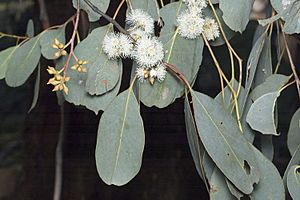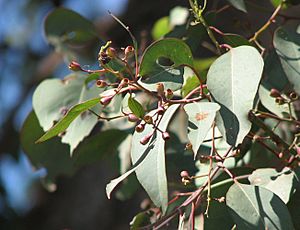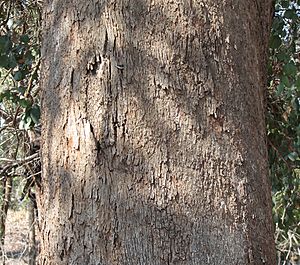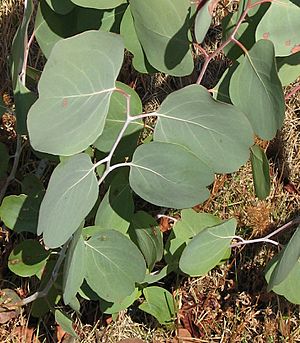Red box (tree) facts for kids
Quick facts for kids Red box |
|
|---|---|
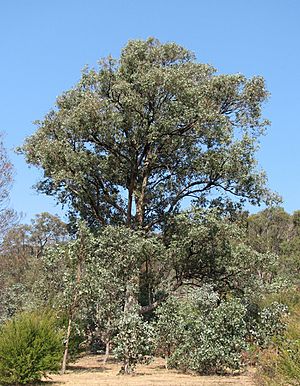 |
|
| Eucalyptus polyanthemos subsp. vestita at Christmas Hills, Victoria | |
| Scientific classification | |
| Genus: |
Eucalyptus
|
| Species: |
polyanthemos
|
| Synonyms | |
|
|
The Red Box (Eucalyptus polyanthemos) is a type of tree found mostly in eastern Australia. It's a small to medium-sized tree, but it can grow quite tall. People have also planted it in other countries.
This tree has rough, stringy bark on its trunk and bigger branches. Higher up, the bark is smooth and can be grey, cream, or yellow. Sometimes, the whole tree has smooth bark. Its leaves can be egg-shaped or round when young. Adult leaves can be spear-shaped, egg-shaped, or almost round. Its white flowers grow in groups of seven, and its fruit looks like a small barrel or cone.
Contents
What the Red Box Looks Like
The Red Box tree usually grows up to 20 meters (about 65 feet) tall. It often has a bent trunk and a rounded top of greyish leaves.
Young Red Box plants have green to bluish-grey leaves. These leaves are broadly egg-shaped or round. They are about 2.5 to 8 centimeters (1 to 3 inches) long and 2.5 to 6.5 centimeters (1 to 2.5 inches) wide.
The leaves on older trees are dull green to bluish or greyish on both sides. They can be spear-shaped, egg-shaped, or round. These leaves are about 5 to 11 centimeters (2 to 4 inches) long and 1.8 to 5 centimeters (0.7 to 2 inches) wide.
The tree's flower buds grow in groups of seven at the ends of its small branches. Each group of buds sits on a stalk called a peduncle. The individual buds are oval to diamond-shaped. They are about 3 to 5 millimeters long and 2 to 3 millimeters wide.
Red Box trees usually flower in October and November, which is spring in Australia. Their flowers are white. After flowering, the tree produces woody, barrel-shaped or cone-shaped fruits. These fruits are about 3 to 6 millimeters long and wide.
How the Red Box Got Its Name
The Red Box tree was first officially described in 1843 by a scientist named Johannes Schauer. He based his description on a sample collected near Bathurst, New South Wales, in 1822.
The name polyanthemos comes from ancient Greek words. Poly- means "many," and anthemon means "flower." So, polyanthemos means "many flowers," which describes the tree well!
Scientists recognize four main types, or subspecies, of Eucalyptus polyanthemos:
- Subspecies longior is a taller tree with rough bark and spear-shaped adult leaves. It was first described in 1996.
- Subspecies marginalis is a tree that grows up to 12 meters (about 39 feet) tall. It has greyish-brown, often flaky bark and egg-shaped leaves. It was first described in 2004.
- Subspecies polyanthemos usually has smooth bark that peels off in large pieces. Sometimes, some rough bark stays on the trunk.
- Subspecies vestita usually has grey-brown, flaky, or fibrous bark on its trunk and larger branches. It was first described in 1960.
Where the Red Box Lives
The different subspecies of Red Box grow in various parts of eastern Australia.
- Subspecies longior is found in taller forests in eastern Victoria.
- Subspecies marginalis also grows in Victoria, between the Greater Bendigo National Park and Stawell. It prefers dry, gravelly soils in forests or woodlands.
- Subspecies polyanthemos is common on the slopes and tablelands of central and southern New South Wales.
- Subspecies vestita is found in both Victoria and New South Wales. It grows in woodlands, often on poor, stony soils on ridges and slopes.
Red Box in Nature
The leaves of the Red Box tree are a food source for some insects. For example, the larvae (young stage) of the moth species Trichiocercus sparshalli and the eucalyptus leaf mining sawfly Phylacteophaga froggatti eat its leaves.
Large, old Red Box trees can develop hollows inside their trunks. These hollows are important homes for animals, including owls like the barking owl (Ninox connivens).
The Red Box has also been planted in other places, like California in the United States. There, it is sometimes called silver dollar gum. In some areas, it has become an invasive species, meaning it grows so well that it can take over from local plants.
Special Red Box Trees
Some Red Box trees are very famous or important:
- A Red Box tree in Fraser National Park in Victoria is listed on the Significant Tree Register. This means it's recognized as a very important tree. It's about 80 years old and 26.7 meters (about 87 feet) tall. It has unusual twisted branches.
- In Gilmore, a tree known as Murumbeeja Scarred Red Box No 1 is listed on the Register of the National Estate. This is a scarred tree, which means it has marks from when Aboriginal people removed bark from it. They likely used the bark to make things like canoes.
Uses of the Red Box Tree
Growing Red Box Trees
The Red Box tree is known for being able to handle dry weather. Even though it usually grows slowly, new trees can grow faster if they have good soil, proper drainage, and enough water in their first two years. This tree is also strong against a type of root disease called Armillaria root rot.
To grow well, the Red Box needs a minimum temperature of about -10°C (15°F).
Red Box in Flower Arrangements
The young leaves of the Red Box tree are often used in flower arrangements. They add a nice look to bouquets and displays.
Red Box Timber
The wood from the Red Box tree is red. It is known for being strong, hard, and lasting a long time. Because of these qualities, it has been used for things like fence posts, railway sleepers (the wooden beams that support train tracks), and firewood.
See also
 In Spanish: Eucalyptus polyanthemos para niños
In Spanish: Eucalyptus polyanthemos para niños


